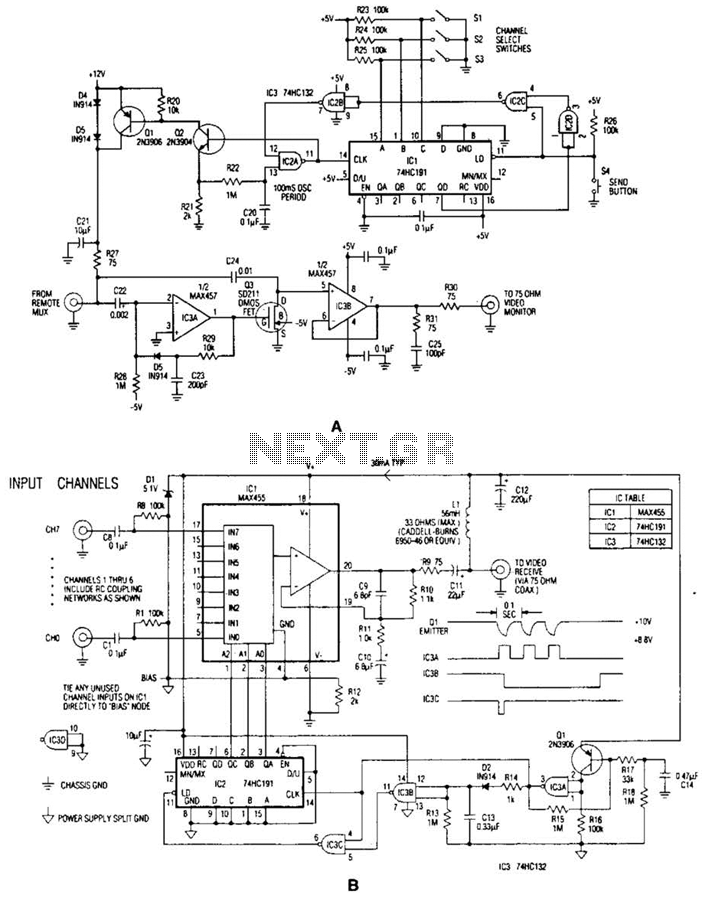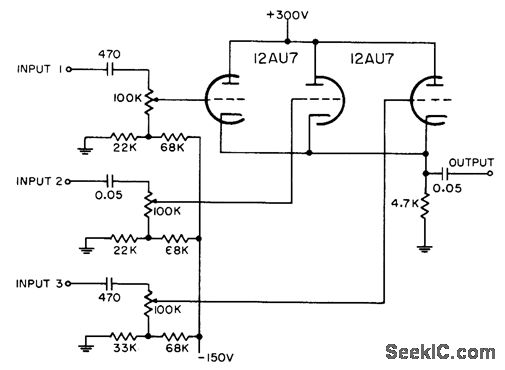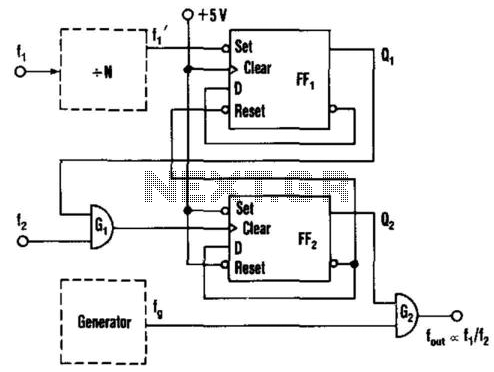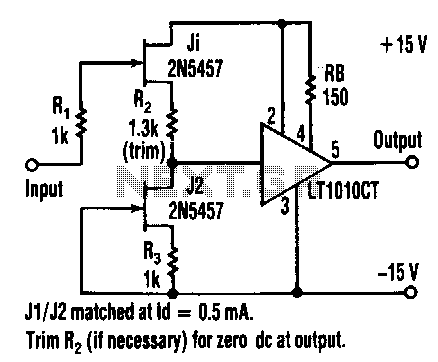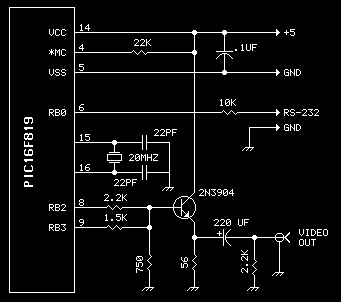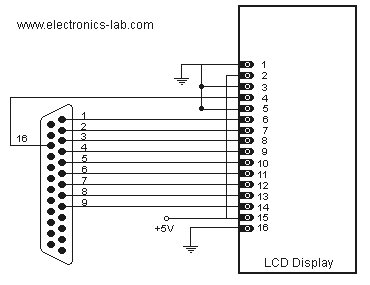
lm1881 video sync for tv and lcd monitor separator
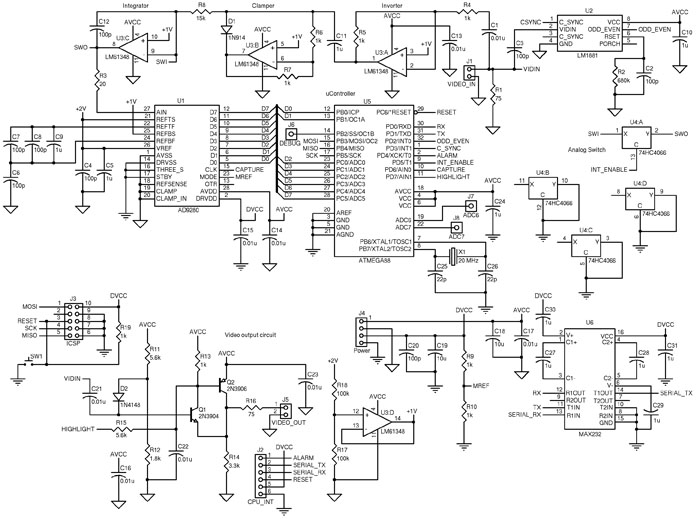
The circuit includes an ATmega88 as the main controller, an AD9280 ADC, an LM6134 high-speed quad op-amp, an LM1881 video sync separator, a 74HC4066 as a simple analog switch, and an RS-232 level converter. The LM1881 video sync separator extracts timing information, including composite and vertical sync, burst/back porch timing, and odd/even field information from standard negative-going sync NTSC, PAL, and SECAM video signals with amplitudes ranging from 0.5V to 2V peak-to-peak. The connections include RGB Blue Ground, RGB Blue Signal (0.7Vpp 75 ohm), RGB Green Ground, RGB Green Signal (0.7Vpp 75 ohm), RGB Red Ground, RGB Red Signal (1Vpp 75 ohm), Composite Video Ground, Composite Video Out (1Vpp 75 ohm), and Composite Video In (1Vpp 75 ohm).
The circuit design integrates several key components to facilitate video signal processing and synchronization. The ATmega88 microcontroller serves as the core processing unit, managing data acquisition and control signals. The AD9280 analog-to-digital converter (ADC) is employed for converting analog video signals into digital format, enabling further processing by the microcontroller.
The LM6134 high-speed quad operational amplifier is utilized for signal amplification and buffering, ensuring that the video signals maintain integrity and minimal distortion during processing. The LM1881 video sync separator plays a crucial role in extracting synchronization information from composite video signals, which is essential for maintaining proper timing in video applications. It operates effectively with various video standards, including NTSC, PAL, and SECAM, accommodating a range of signal amplitudes.
The 74HC4066 analog switch allows for the routing of signals within the circuit, enabling flexible signal management without introducing significant noise or distortion. Additionally, the RS-232 level converter facilitates communication between the microcontroller and external devices, ensuring compatibility with standard serial communication protocols.
The RGB signal connections are designed to interface with various video sources, with specific grounding and signal specifications for each color channel (Red, Green, and Blue), as well as composite video inputs and outputs. Each signal line is characterized by a specified voltage level and impedance (75 ohms), which is essential for maintaining signal quality and preventing reflections in high-frequency applications.
Overall, this circuit is well-suited for applications requiring video signal processing, synchronization, and conversion, providing a robust platform for further development in video electronics.The chips include an ATmega88 as the main controller, an AD9280 ADC, an LM6134 high-speed quad op-amp, an LM1881 video sync separator, a 74HC4066 as a simple analog switch, and an RS-232-level converter. LM1881 Video sync separator extracts timing information including composite and vertical sync, burst/back porch timing, and odd/even field inform
ation from standard negative going sync NTSC, PAL* and SECAM video signals with amplitude from 0. 5V to 2V p-p. 5 RGB Blue Ground 7 RGB Blue Signal (0. 7Vpp 75 ohm) 9 RGB Green Ground 11 RGB Green Signal (0. 7Vpp 75 ohm) 13 RGB Red Ground 15 RGB Red Signal (1Vpp 75 ohm) 17 Composite Video Ground 19 Composite Video Out (1Vpp 75 ohm) 20 Composite Video In (1Vpp 75 ohm) 🔗 External reference
The circuit design integrates several key components to facilitate video signal processing and synchronization. The ATmega88 microcontroller serves as the core processing unit, managing data acquisition and control signals. The AD9280 analog-to-digital converter (ADC) is employed for converting analog video signals into digital format, enabling further processing by the microcontroller.
The LM6134 high-speed quad operational amplifier is utilized for signal amplification and buffering, ensuring that the video signals maintain integrity and minimal distortion during processing. The LM1881 video sync separator plays a crucial role in extracting synchronization information from composite video signals, which is essential for maintaining proper timing in video applications. It operates effectively with various video standards, including NTSC, PAL, and SECAM, accommodating a range of signal amplitudes.
The 74HC4066 analog switch allows for the routing of signals within the circuit, enabling flexible signal management without introducing significant noise or distortion. Additionally, the RS-232 level converter facilitates communication between the microcontroller and external devices, ensuring compatibility with standard serial communication protocols.
The RGB signal connections are designed to interface with various video sources, with specific grounding and signal specifications for each color channel (Red, Green, and Blue), as well as composite video inputs and outputs. Each signal line is characterized by a specified voltage level and impedance (75 ohms), which is essential for maintaining signal quality and preventing reflections in high-frequency applications.
Overall, this circuit is well-suited for applications requiring video signal processing, synchronization, and conversion, providing a robust platform for further development in video electronics.The chips include an ATmega88 as the main controller, an AD9280 ADC, an LM6134 high-speed quad op-amp, an LM1881 video sync separator, a 74HC4066 as a simple analog switch, and an RS-232-level converter. LM1881 Video sync separator extracts timing information including composite and vertical sync, burst/back porch timing, and odd/even field inform
ation from standard negative going sync NTSC, PAL* and SECAM video signals with amplitude from 0. 5V to 2V p-p. 5 RGB Blue Ground 7 RGB Blue Signal (0. 7Vpp 75 ohm) 9 RGB Green Ground 11 RGB Green Signal (0. 7Vpp 75 ohm) 13 RGB Red Ground 15 RGB Red Signal (1Vpp 75 ohm) 17 Composite Video Ground 19 Composite Video Out (1Vpp 75 ohm) 20 Composite Video In (1Vpp 75 ohm) 🔗 External reference
